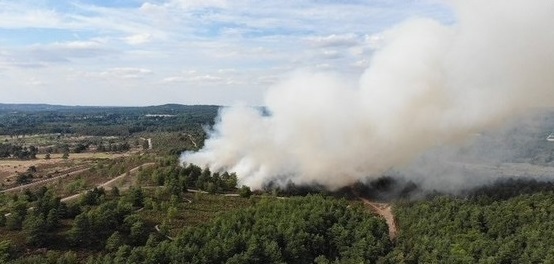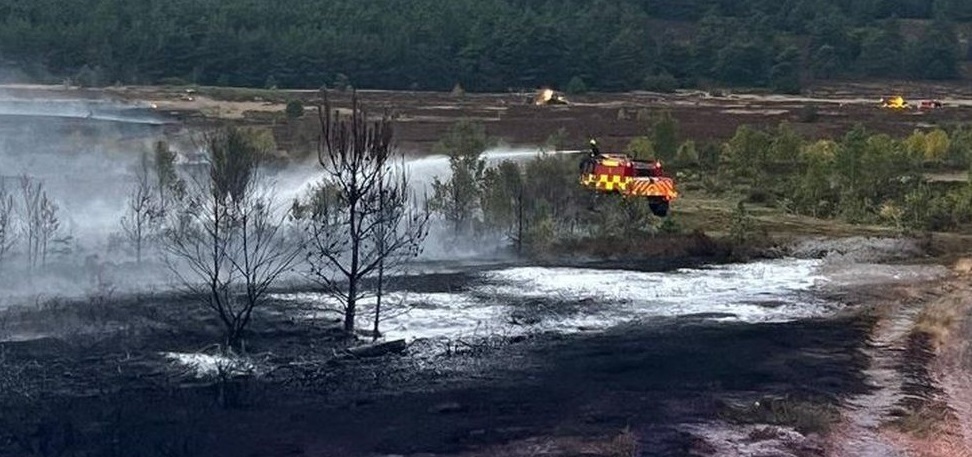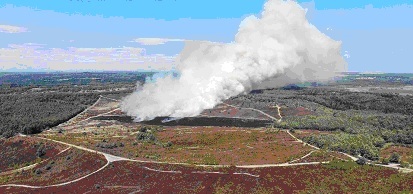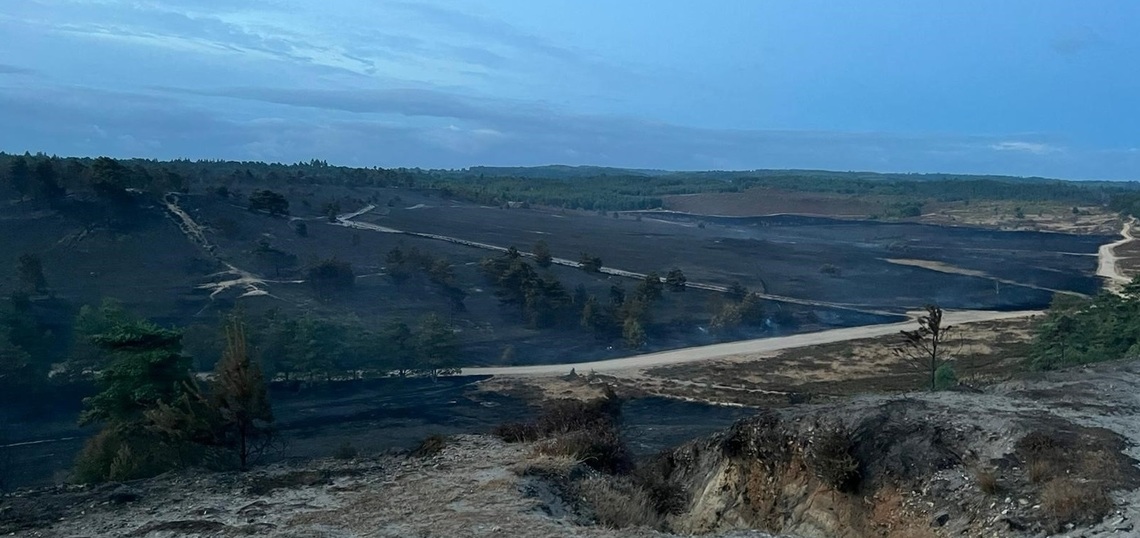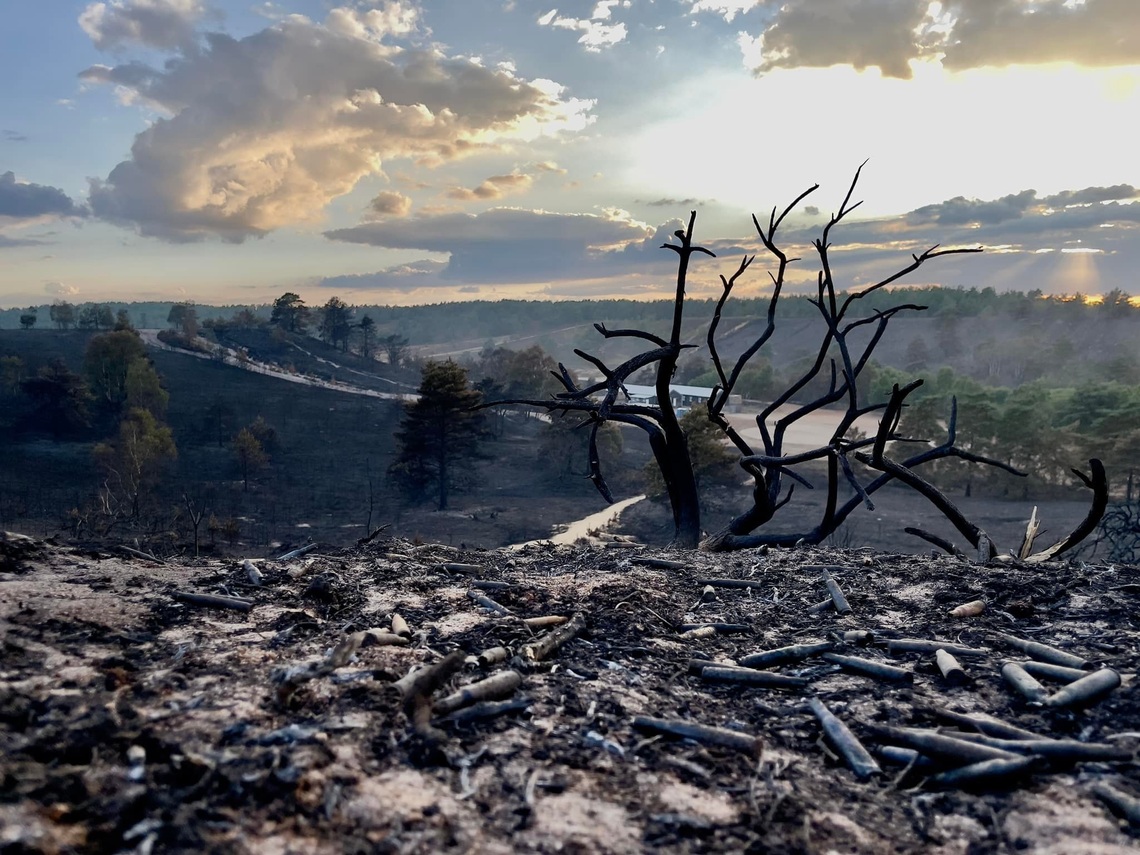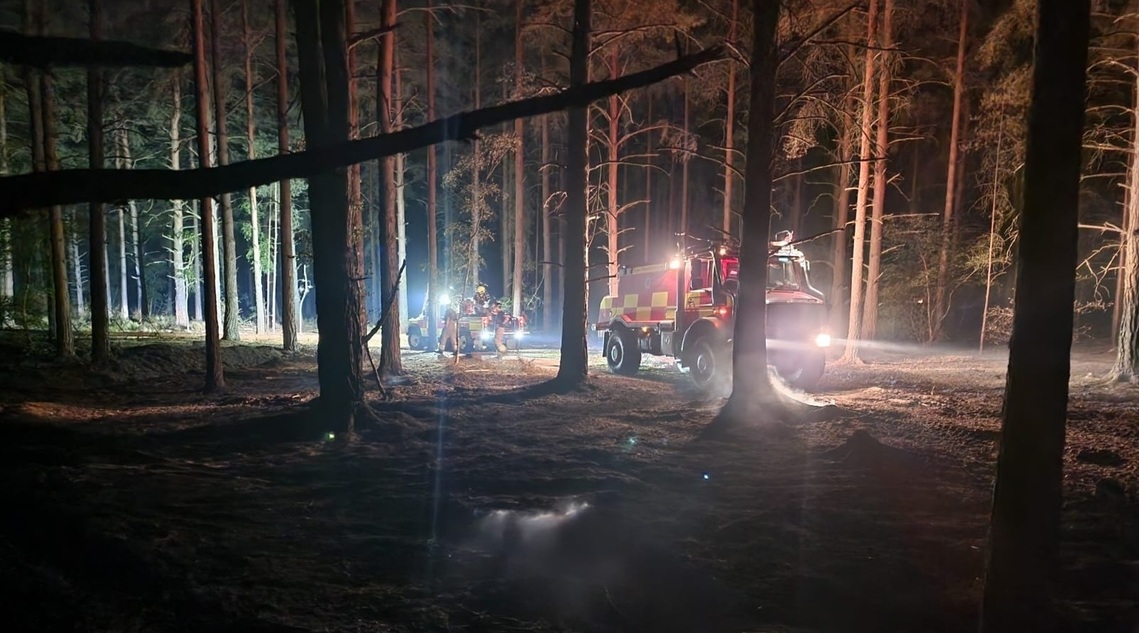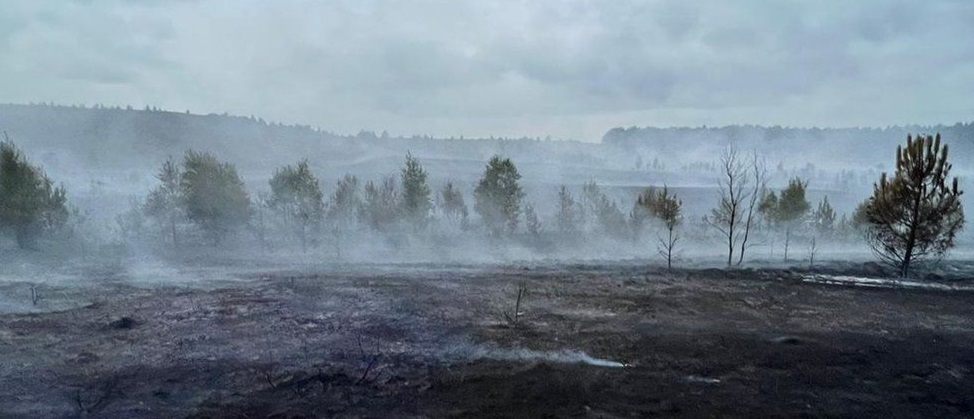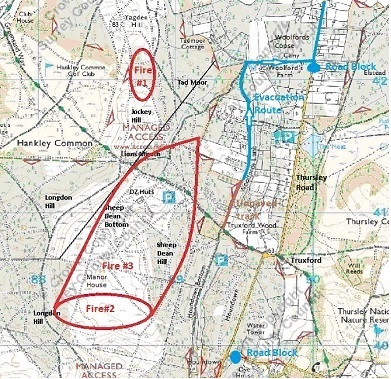A private report on the three fires on Hankley Common between July 13th and 28th. Text based on personal observation, photos from SFRS and other Facebook sources.
Michael Organe 31/07/2022
1. Wednesday July 13th. The first fire started south of Yagden Hill on the ridge that runs above the boundary of the Hankley Golf Course. The wind was NW and the fire moved down the hill towards Bridleway 74 but was stopped before it reached the bridleway.
2. Wednesday July 20th. The second fire started in the early evening in the southern part of the DZ between the locations of the Skyfall Manor House and the Chapel. The wind was Easterly and the fire moved towards the West across the DZ and was extinguished that night.
3. Sunday July 24th. The third fire started on Sunday morning in the area of the second fire and was driven NE by a very strong SW wind across the DZ and up onto the ridges on either side.
It passed the DZ huts on both sides and crossed the eastern ridge and the power line at the centre car park, then continued across Bridleway 101 down through the woods towards Woolfords Lane.
By 2:30 pm the smoke on Woolfords Lane was intense and residents and farms on Woolfords Lane were evacuated, together with Army trainees and some misdirected motorists who had driven along Woolfords Lane in an attempt to bypass the Police road block at the junction with the Thursley Road.
The fire was stopped in the woods at the end of the garden of the first house on Woolfords Lane.
Firefighters remained in the area for another four days damping down the area with the help of a helicopter dropping water.
Comments on the fires.
The second fire zone was smoke free and cool enough on Friday 22nd for people to have no problem collecting cartridges for their scrap value.
Whatever started the first and second fires the third one appears from the photo of the second fire zone to have been spontaneous.
In general this appears to have been a fast moving ground level grass and brushwood fire that did not linger long enough to get into the tree tops once it entered the pine woods. As a result it did not develop into the sort of fire-storm that has occurred elsewhere.
The third fire travelled a distance of approximately 1.6 km during Sunday afternoon and evening, from its start point in Fire Zone #2 to its furthest point in the woods West of Woolfords Lane. If it had not been stopped before reaching Tad Moor and Woolfords Copse the same distance again would have taken it to the edge of Pot Common in Elstead.
Police Roadblocks.
I went to Woolfords Lane at about 2:00pm on Sunday 24th to assess the extent of the fire and the risk to the village. The Police were setting up a road block at 2:00 p.m. on the Thursley Road and initially turned all traffic back towards Elstead. A steady stream of traffic coming from Thursley indicated that no second block in that direction had yet been established. I turned down Woolfords Lane to check the position of the fire and it was clearly heading in the direction of the houses on the Lane. A resident told me that they were preparing to evacuate following telephone advice from the Fire Service..
Driving back along Woolfords Lane to Thursley Road I saw several cars coming the other way towards the fire zone and told them that the lane was not suitable as a through route because of the very rough unmade section beyond the last house and the location of the fire. I directed them to a point a little further on where the lane was wide enough to turn round.
I then returned to the Police road block and told them that Woolfords Lane is narrow, not suitable for through traffic and vehicles driving along it were going towards the fire zone. They would also interfere with the evacuation of residents and horses from Woolfords Farm. After consulting with their control room they stopped traffic from turning down the lane. By then the smoke from the fire was becoming very thick and the Police moved their road block into the village.
It seems clear that the Police lacked local knowledge and that some form of emergency liaison between the Parish Councils and the emergency services would reduce confusion in the future. In particular they were unable to give any information to residents about evacuation procedures.
The Army.
A number of troops under training were on Hankley Common during Fire #3. They were evacuated with some difficulty when the fire approached the DZ huts. I understand that in 1976 the Army played a big role in fighting a fire on Hankley Common. I suggest that in future the MOD should keep some fire fighting equipment at the DZ Huts and that soldiers should have basic fire-fighting training so that fires could be attacked earlier.
Surrey Fire and Rescue Service did a great job in very difficult conditions. I understand that they had considerable problems due to inadequate fire breaks in some parts of the Common, something that the MOD will need to improve.
Civilian support. As on previous occasions local farmers and fire fighters provided water supplies and equipment in support of SFRS. A bulldozer was used to establish a firebreak stop line along Bridleway 74 along the edge of the woodlands, which runs north round Tad Moor and Yagden Hill.
Conclusions.
The wind played a major part in all three fires, Northwest for the first, East for the second and Southwest for the third, so the first two were not a direct threat to Elstead or any or the other villages. The third fire was a definite threat to Elstead in the Woolfords Lane and Thursley Road areas. It moved approximately 1.6 km towards Elstead in the afternoon and evening of Sunday 24th before it was stopped in the woods adjacent to gardens on Woolfords Lane. Further progress at the same speed and direction could have brought it to Pot Common overnight if it had not been stopped.
Actions by the Police showed a lack of local knowledge and common sense, as motorists heading for Thursley or Churt were allowed to drive down Woolfords Lane (a gated and partly unpaved private road) towards the fire zone, to bypass the road block on the Thursley Road. Given the single-track width of the lane this would have severely impeded the evacuation of residents and animals from the area especially as the smoke intensified rapidly during the hour the I was there. I would recommend that in future Parish Councils should establish close liaison on the ground with both emergency services.
I am also of the opinion that complete closure of the Thursley Road at the Churt end early in the afternoon was not necessary. It would have been equally justified to close the Tilford Road in Rushmoor, which was nearer to the fire zone than the Churt/Pitch Place side of Hankley. Closure between Dye House Lane and the Elstead village boundary was clearly necessary immediately, if only to ensure safe evacuation of residents and animals from the area. Closing Thursley Road within Elstead village seemed excessive. A warning of the road being closed ahead should have been enough.
I feel that the Army should take more responsibility for safeguarding Hankley from fires, partly by the provision of equipment at the DZ huts but also by giving trainees basic fire fighting training. This should make it easier for fires to be stopped at an earlier stage before they get out of control. The firing of blank cartridges when the fire risk is very high seems unwise and a ban on smoking might also be advisable. There are areas of closely packed young trees at the southern end of Hankley Common that are a serious fire risk and fire breaks in that area are inadequate. Previous fires in that area were only just prevented from entering the mature woods on Kettlebury Hill above Pitch Place.
Smoke in Elstead was a health hazard and no warnings were given in the village. The Elstead Emergency Plan was not activated.
Michael Organe
